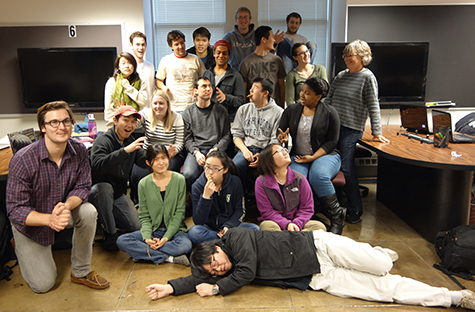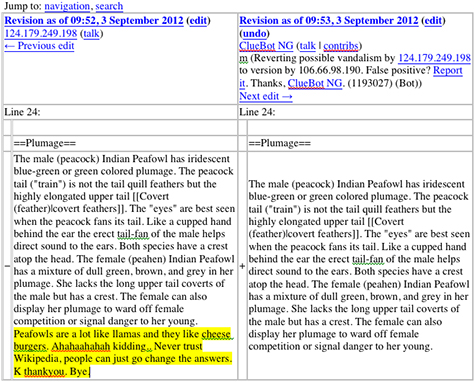
If you go to the Wikipedia entry on “peafowl” and click on the “talk” tab, you can read a comment made Sep. 25, 2012, critiquing the section on peacock tails. (Peacocks’ iridescent many-eyed tails are something of a biological puzzle because they can be so heavy the birds can barely walk — so the question has always been what benefit they confer that outweighs the obvious disadvantage.)
The writer pointed out that the article espoused the view that females are indifferent to male plumage, but cited only one study done in Japan in support. Several other studies, the writer said, show that the number of eyespots in a male’s train predict his success with peahens.
When nobody answered, the writer dove in and overhauled the article, describing competing explanations for the peacock’s tail and the evidence for each. Wikipedia’s “view history” tab allows you to compare two versions of this section of the article.
The writer was Eamon Callison, a senior in biology in Arts & Sciences at Washington University in St. Louis and a student in a fall behavioral ecology course taught by Joan Strassmann, PhD, professor of biology.
The course had some of the accoutrements of a traditional course, including a textbook, study questions and quizzes, but it was also an official Wikipedia course. Students had to edit an existing Wikipedia entry and then either add 25 references and 2500 words to a second entry or begin a new one. The goal was to bring at least one article up to what is called Good Article status by the end of the course.
“I made it really clear right from the beginning that no work by students as good as Washington University’s students should ever end up in a professor’s drawer,” says Strassmann. “It was their responsibility as smart people who were getting a great education to help others.”
“It was nice to create something that somebody other than the teacher will see and benefit from,” says Gabriel Hassler, a senior majoring in anthropology and biology in Arts & Sciences who took the course.
A crash course on how to be a scholar
Strassmann says she never teaches in a conventional way, but rather continually experiments with different types of “active learning,” a term used to describe any of several teaching methods that place the responsibility of learning on the learners.
“The Wikipedia course required the students to behave as active scholars rather than as a traditional students,” Strassmann says. To write for Wikipedia, for example, they had to learn how to support assertions by citing credible primary sources, describe debates or controversies from a neutral point of view, decide the scope of the article and how to structure it, and how to write an engaging lead.
Because students had to have 10 sources before writing and these couldn’t be Wikipedia articles, Hassler says he learned how to read scientific literature quickly and efficiently. “That was what helped me the most,” he says.
“The course was speeded-up training in scholarship, if scholarship is being able to assess sources and put everything together in a conversation about the topic,” says Kevin Li, a classmate who graduated with a degree in biology neuroscience in December.
“Reading primary journals and then trying to rewrite the material so that it would be accessible to everyone required a higher level of synthesis than some of my other classes,” says Samara Levine, an anthropology major and public health and biology minor who worked on entries about crested auklets and the red-collared widowbird. “In most classes, you talk about things at the same level as they’re taught and that doesn’t necessarily translate into understanding the concepts.”
Defending your arguments
Because the students were writing for Wikipedia, their work was scrutinized at a high level. The students had to defend their work not just to fellow class members — each article was reviewed by two other students in the class — but also to Wikipedia editors.
The students were protected to some extent by the official class banner that ran above and below their entries on talk pages, but this did not guarantee immunity to criticism. Wikipedians, who are overwhelmingly young and male, sometimes take the gloves off behind the scenes.
Some topics were also “hotter” than others, the students said. Many of the students had written about birds, for example, and the bird project editors have strong opinions, they report, while articles on primates, rather surprisingly, got a pass.
In one case, two students, told to add to the fabric of knowledge by linking their article to 10 other articles, linked to the article on Europe. This turned out to be a violation of the encyclopedia style Wikipedia cultivates. “Europe is a very general article summarising topics that are treated in much greater detail in sub-articles. Adding small details to the biodiversity section (e.g. on the Macaque colony in Gibraltar) is WP:UNDUE,” a Wikipedia editor complained.
“There were people who were a little critical,” says Hassler, “but mostly people were saying I’m going to fix this and this, but overall you did a great job.”
The students gathered confidence as they went, Strassmann says. “At first, they were hesitant. They weren’t sure they were right. But I said, ‘Well, if Washington University undergrads can’t get this right, who can?’”
Media literacy 101
Most of the students in Strassmann’s class had been warned in middle or high school not to use Wikipedia as a source because many people doubted that a free encyclopedia anyone could edit could be reliable.

In the past 10 years, Wikipedia has won most skeptics over. There have been hoaxes on Wikipedia, to be sure, but Wikipedia being Wikipedia, it posts a list of them for all to see.
Good articles in the sciences, at least, are ultimately grounded in citations from the peer-viewed primary literature. But Wikipedia also polices its site much more vigorously than casual readers may realize.
Roughly 1,500 administrators have the power to block or ban user accounts and IP addresses and protect and unprotect pages from editing.
They are assisted by a team of robots, programs written by other Wikipedians, such as ClueBot NG, a robot that searches for and deletes vandalism.
Li says writing for Wikipedia made him a much more sophisticated consumer of online information. “At the end of the class, we were asked to nominate an article for Good Article status, he says. I nominated an article on amyotrophic lateral sclerosis (Lou Gehrig’s disease). Within three hours, a Wikipedia editor had reviewed it and said it wasn’t good enough. I was startled and took a look at the comments. Then, I could see that the sources really weren’t very credible and the writer had thrown in some extraneous facts among the gold.”
Four students achieved Good Article status by the time the course ended: Hassler (the chacma baboon), Tony Zhang (the scaly-breasted munia), Andrew Katims (the vervet monkey) and Li (worker policing). Li also was profiled on the Wikimedia Foundation blog in December.
Unleashing students
In his profile, Li called Wikipedia “a miniature classroom for yourself.” He said he preferred Wikipedia assignments to traditional term papers both because there is a much larger audience for his work and because he prefers the collaboration with classmates and Wikipedia editors to working in isolation.
Research done after the pilot for the Wikipedia Education Program showed that 72 percent of students preferred a Wikipedia assignment to a traditional assignment.
“I enjoyed the course and it really changed the way I thought about learning,” says Levine.
“These are very smart kids and they really respond to being treated as scholars who can write for Wikipedia and defend what they’ve written,” says Strassmann.